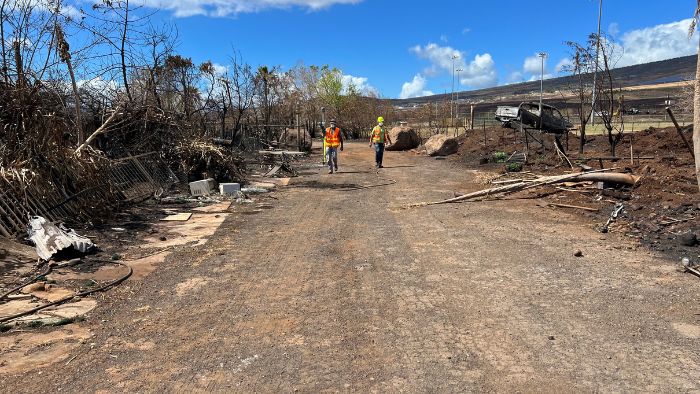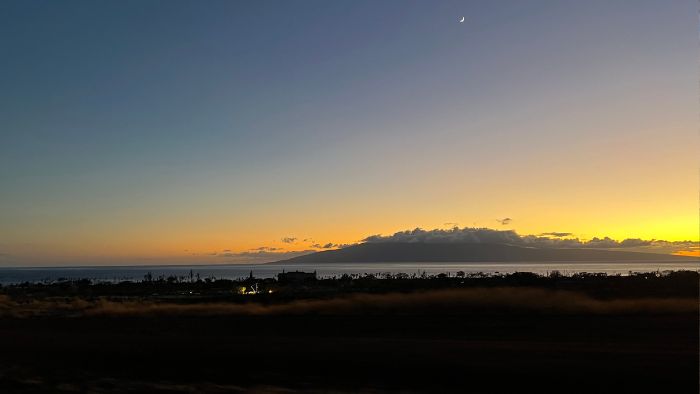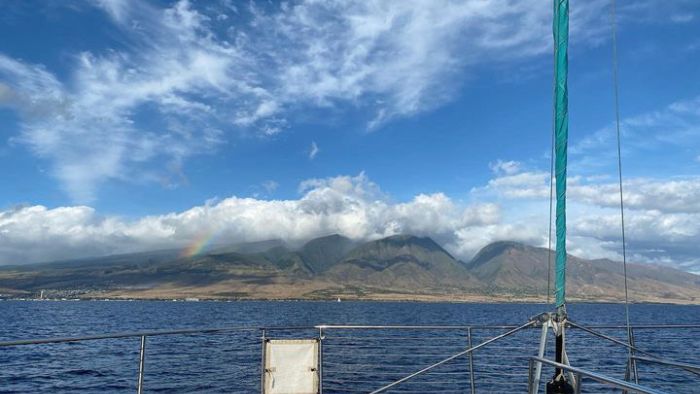The sun always felt warmer in Lāhaina. For the past two months, I’ve searched my mind for every memory of the town and what it looked like before the wildfires swallowed it whole. Most of them are from my summers in high school, when my family and I would drive along the winding road that connects West Maui to the island’s center—a road that terrified me when I was learning to drive because of all the twists and turns over a rocky cliff.
One of the most well-known parts of the town is Front Street. Newscasters often described it as ‘a popular tourist destination’ in the immediate aftermath of the wildfires, but many don’t know just how lively of a place it was for vacationers and locals alike before it burned. I remember the days my friends and I would spend “playing tourist” there, people-watching as crowds of actual tourists passed by. I remember the smell of salt that filled our lungs every time the waves crashed against the rock wall that separated the road from the ocean, splashing water on our skin. The wreckage that lines the strip today used to be an endless buffet of restaurants that were always open and ready to serve us whatever local dish we were craving for the day, whether it be a warm loco moco or a plate of chicken katsu. We would stand in lines that wrapped around the block for the famed Ululani’s Hawaiian Shave Ice, waiting our turn for the cold treat that would stain our tongues blue. Not far from it was Tamura’s, the grocery store where we’d get fresh poke that we’d throw in our cooler before heading to the beach.
And then there was the wise, banyan tree at the heart of town; her shade offered us refuge from the heat every time we paid her a visit. I’d always run my hand along her trunk to greet her warmly—in awe of how tall she’d stood for over a century—before we’d part ways again.
My decision to move from Maui to California two years ago for work wasn’t an easy one. Even when I was packing my bags, leaving behind the only place I’d ever called home and 21 years of memories like these felt impossible. I could barely bring myself to look outside my airplane window as the island—my island—disappeared from view.

It was only a matter of weeks before homesickness took hold like a weight in my chest that, to this day, is still too heavy for me to carry sometimes. Until four months ago, I found comfort in the thought that Maui would be exactly how I left it: ready to welcome me back with open arms when I return one day to be with my people again.
But now, a town I thought would outlive me has perished. When reports of the fire first emerged August 8th, I was in denial. The thought of the only place I’ve ever called home burning down sounded like a deranged nightmare fueled by diaspora guilt. Even as I was frantically calling and texting my family and friends to make sure they were alive, I still hoped I’d wake up somehow.
But as video after video of people running for their lives from the smoke and flames poured in, I knew I never would. Grief washed over me when I saw Front Street’s storefronts covered in ash. Homes, businesses and schools were completely destroyed. Cultural archives and museums with priceless historical artifacts were lost. And perhaps most heartbreaking of all was the sight of Lāhaina’s banyan tree covered in soot—not dead, but fighting to stay alive—after thriving for 150 years.
The testimonials that followed were unbearable as authorities began identifying the 98 people who died. Survivors spoke of dead bodies floating in the ocean after people had no choice but to jump into open water to flee the flames. A Lāhaina mother buried her fourteen-year-old son at his favorite park on what would have been his fifteenth birthday. Some pet owners grieved their loyal companions who didn’t survive the fires, while others desperately searched for the thousands that remain missing. To this day, I still read GoFundMe after GoFundMe pleas from families who lost everything in the fires, asking anyone who will listen to help them rebuild what they can never replace, with tears in my eyes.
The generational trauma of being Native Hawaiian—or, Kānaka Maoli—felt heavier in my body as the scale of the tragedy became clearer with each day. I thought of how my people had survived so much at the hands of U.S. imperialism—the illegal overthrow of our sovereign kingdom, the suppression of our culture and our language, and an ongoing unlawful occupation by a settler-colonialist state that does nothing but poison our water and bomb our land—just to endure one of the deadliest wildfires in modern U.S. history. I thought about how long my people had fought to make sure we weren’t erased from history ever since Western contact and how we’ll make sure the story of Lāhaina—the first capital of the Hawaiian Kingdom—is never lost.

I live in fear that my memory will fail me as I get older, and I’ll forget what Lāhaina looked like beyond the pictures on Google—how much warmer the sun felt and how much brighter it shined. It hurts knowing there are moments I’ve already forgotten without realizing just because so much time has passed. All I can do now is cling to the distant memories I have of the town, knowing that I will never be able to make new ones.
The people of Lāhaina and the loss they have suffered may not be front of mind for people now that the fires have left the news cycle. The world keeps turning as more tragedies take hold, but I urge folks to remember that the things that were lost in West Maui—a place many only know as a vacation destination—span far beyond material belongings.
I may have forgotten a day or two from my childhood, but the people of Lāhaina—my neighbors who, to this day, refuse to leave their homes—have lost entire histories and futures. And an entire generation will grow up wishing they could forget everything as easily as the rest of the world did when they turned off the news.
The road to recovery will be endless. I have no doubt that we will continue to survive, the way we have for centuries now. But when will it finally be our turn to live without fear that our stories will be forgotten?

This article appeared in Character Media’s Annual 2023 Issue.
Read our full e-magazine here.









